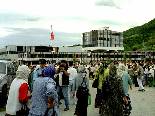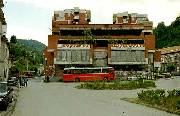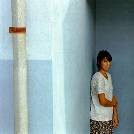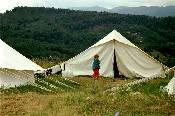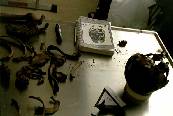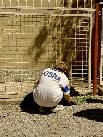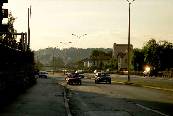|
||||
| Kladanj | ||||
| The commemoration ceremony in Potocari on 11 July 2000 marked the fifth anniversary of the massacre in Srebrenica. Joining the convoy of buses to Potocari was a complicated procedure. The "freedom of movement" condition in the Dayton agreement appeared to be no obstacle for Bosnian Serbian officials to restrict the number of buses that was allowed to go. Before entering Republika Srpska, approximately 60 buses gathered in Kladanj for a thorough inspection of the passengers and the vehicles by policemen of the Bosnian-Croat federation. Everything that could possibly provoke the Serbs, like posters and fruit knives, had to be removed from the buses. | ||||
| Convoy across Republika Srpska | ||||
|
Our trip to Potocari across Republika Srpska was depressing. The traces of the war are still evident. Along the road, we saw desolated cornfields and an endless row of burned and destroyed houses. Some of them are marked by the name Arkan in Cyrillic script. The Bosniacs who had joined us in the bus told us the gruesome stories that are connected to the places we passed on our way. Every 100 or 200 metres a Serbian policeman stood at the side of the road. Serbian adults and children made nationalistic gestures by sticking three fingers in the air. Sometimes they made throat-cutting signs. In Bratunac, a Serbian crowd had to be controlled by SFOR soldiers. Military tanks were standing by. However sporadically, we spotted some friendly waving in the less populated areas as well. Clearly, not much reconstruction is taking place in this area. Only a few houses are being rebuilt. A shiny white orthodox church elsewhere along the road contrasted the poverty of a Serbian refugee camp and the poor state of housing. |
||||
| The Ceremony | ||||
|
Finally, about three thousand people managed to attend the ceremony at the former Dutchbat compound in Potocari. Not only Sebrenicans, but also many representatives of the international community were present. To mention a few: UN special representative Jacques Klein, High Represententative Wolfgang Petritsch and US Ambassador Thomas Miller. The Netherlands was officially represented by ambassador Fred Racké. The Croat member of the Bosnian presidency Ante Jelavic and President Alija Izetbegovic also joined the ceremony. Reisu-I-ulemu Mustafa Efendi Ceric led the prayer. He spoke to the crowd in Bosnian, Arabic and English and said: "We are not here to judge, nor to absolve. We are not here to seek revenge, nor to forgive. We are here to show that we have not given up and will not give up on justice. We pray that sadness will turn to hope, that punishment will be just, that a mother's tears will be a reminder, and that Srebrenica will never be repeated again." Serbian leaders had not only restricted the number of buses; they also set a time frame for the ceremony itself. So after a brief ceremony of approximately half an hour led by the imam, everyone had to leave. Our group left some flowers at the gate. |
||||
| Srebrenica | ||||
|
On 13 July, we visited Srebrenica. Srebrenica looks like a ghost town. As if the war only ended yesterday. Except for the newly renovated local council house flagged with the Serbian national colours, most of the other buildings are heavily damaged. We met a group of Serbian women who informed us about their miserable living conditions. They live in poverty and there are no jobs to improve their situation. It was encouraging to hear that they were not opposed to the return of Muslims. They also said that they were willing to leave the houses of the Muslims, if only they were given another place to live and to work. They said that they felt as if they were thrown back in the middle ages. They were longing for a normal and better live. |
||||
| Mihatovic | ||||
|
Mihatovic is a big refugee camp near Tuzla. Many displaced persons from Srebrenica live in this camp. The apartments give sufficient shelter, however, each has to be shared by far too many people. Approximately 30 people occupied the house that we visited. The woman on the left of this text showed us her place. She is a former resident of Srebrenica. Her husband, three brothers and her father in law never came back from "safe area" Srebrenica. |
||||
| Suceska | ||||
|
Suceska is a little village in the mountains that was situated in UN "safe area" Srebrenica in the period 1993-95. In July 1995, the village was plundered and destroyed by Serbian troops. Some of the former residents now have returned and try to rebuild their houses under very difficult conditions. Until the time they can move back in their houses, they reside in tents. The village can not be reached by bus. The narrow mountain road that leads to the camp has to be climbed by car or on foot. In Suceska we met Hasib Husejnovic. After the enclave fell in 1995, he succeeded in hiding himself for three months in the surrounding woods. He said that he had been chased like a rabbit before he finally arrived in safe territory. At the time we visited the camp, a young disabled child was staying in one of the tents. She was born during the war. The people in Suceska are still desperately waiting for substantial material aid. |
||||
|
Mortuary in Tuzla |
||||
|
We brought a short visit to the mortuary in Tuzla. In the mortuary, approximately 4000 bags with exhumed human remains are waiting to be identified. A British volunteering forensic anthropologist was examining the human remains. Autopsy and identification of the bodies are not only highly important for the need to know the fate of the missing persons and as evidence for legal cases at the War Crimes Tribunal, but also for relatives who are required to provide an official registration of death to be entitled to receive pension money, etc. For a long time, the process of exhumation and identification has been badly managed by all kinds of (international) organisations including the Bosnian government. This is the reason that still so much work has to be done. The missing persons list of the International Red Cross in Sarajevo currently contains the names of about 7000 Muslims and the list is still growing. Many sites are still to be exhumed. It is one of the accomplishments of the Working Group Netherlands-Srebrenica in co-operation with the British Srebrenica Justice Campaign to have enabled a large-scale DNA identification project. |
||||
| Relief organisations | ||||
|
|
In Tuzla, we visited three relief organisations that support survivors in an (occupational) therapeutic way. The first was Vivi Zene, a therapy centre where women and children live for a period of half a year. The second was Bosfam, led by Munira Beba Hadzic. Many women from Srebrenica are given a platform to meet each other here. They make (beautiful!) carpets to sell and they follow computer courses that can help to make a new living. The third organisation that we visited in Tuzla is called Kuca "Zena I Dijete" Vahida. The women we met in this Swedish-Norwegian centre told us about their experiences of living as a refugee in Tuzla. They pointed at the problem of not living in official refugee centres, but in houses from which they can be evicted when the original owners return. The insecurity of this situation and the bad living conditions appeared to be a huge problem for them. In Tuzla we were welcomed by the organisation Women of Srebrenica and in Vogosca, a suburb of Sarajevo where many refugees from Srebrenica now live, we visited the Mothers of Srebrenica (Association of Citizens "Pokret Majke Enklava Srebrenica i Zepa"). Both organisations deal with issues that are related to the problems of the survivors and to keep Srebrenica on the political agenda of the international community and the national governments. |
|||
| Impressions of Tuzla | ||||
|
Our impressions of Tuzla are rather ambivalent. Everyday, we were collected by our bus in front of Hotel Technograd which is no longer a hotel but a refugee centre. It is impossible not to see the traces of the war and the misery of the survivors and refugees. The friendly couple that hosted us so well in Tuzla had not only suffered from the latest war. Tito's partisans had murdered the man's father during the Second World War and the couple lost their son in Srebrenica during the last war. In the few German words he knew, our host frequently sighed: "Warum?" (Why?) Yet, life is moving on. At night, young people are going out and parade in the streets like in the old days. The city centre almost looks like a normal mediterranean town except for the fact that we do not see any tourists. The minaret is still standing close to the orthodox church. Both are in good condition. |
||||
| Impressions of Sarajevo | ||||
|
Like in Tuzla, Sarajevo at its best looks like a tourist attraction without any tourists. SFOR soldiers are almost the only foreigners who enjoy the beauty of this city. However, we can not ignore the many damaged buildings and the problems that are more hidden from our view. In a New York Times article by Carlotta Gall ("Bosnians, Ending Exile, Cope with Old Hatreds", 30 July 2000) we read about the return of refugees: "'Our policy is ruthless implementation so that all property is returned to its owner. We are using the law to subvert ethnic territorialism,' said David Stewart-Howitt, a former British Army officer who coordinates the property returns at the Office of the High Representative. 'What we have to ensure is a blending that can allow this country to knit together. The authorities are evicting people from homes so owners can reclaim their property. There are 25 to 45 evictions every week in Sarajevo,' Mr. Stewart-Howitt said. 'Muslims are being evicted here, the local police are dragging people out, war veterans get involved, then we have street protests,' he said. 'It's happening all over the country. It's a very difficult process but it's happening.' (...) Of 750,000 people displaced in Bosnia, about 220,000 have made claims for the return of their homes under the property laws. To date, 17 percent of those claims in the Muslim-Croat federation have been settled and 7 percent so far in the Serbian entity, known as Republika Srpska." |
||||
|
|
||||
| |
||||


